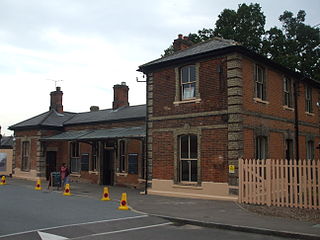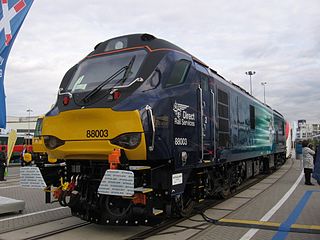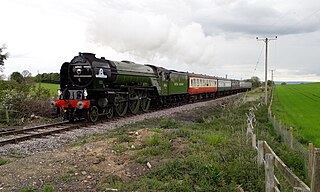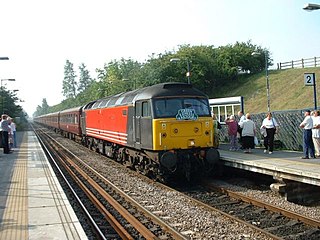
The Class A4 is a class of streamlined 4-6-2 steam locomotive designed by Nigel Gresley for the London and North Eastern Railway in 1935. Their streamlined design gave them high-speed capability as well as making them instantly recognisable, and one of the class, 4468 Mallard, holds the world record as the fastest steam locomotive. Thirty-five of the class were built to haul express passenger trains on the East Coast Main Line route from London Kings Cross via York to Newcastle, and later via Newcastle to Edinburgh, Scotland. They remained in service on the East Coast Main Line until the early 1960s when they were replaced by Deltic diesel locomotives; they themselves proving to be worthy successors to the A4s. Several A4s saw out their remaining days until 1966 in Scotland, particularly on the Aberdeen – Glasgow express trains, for which they were used to improve the timing from 3.5 to 3 hours.

Ongar railway station is a station on the Epping Ongar Railway heritage line, and a former London Underground station in the town of Chipping Ongar, Essex. It was opened in 1865 by the Great Eastern Railway, and became part of London Transport in 1949. Until its closure as such in 1994, it was the easternmost point of the Central line and the eastern buffers remain the point from which all distances on the London Underground are measured.

Direct Rail Services (DRS) is a rail freight company in Great Britain. As of 2022, it is one of seven publicly owned railway companies in the United Kingdom, the others being NI Railways, LNER, Northern Trains, Southeastern, Transport for Wales Rail and ScotRail.

The British Rail Class 14 is a type of small diesel-hydraulic locomotive built in the mid-1960s. Twenty-six of these 0-6-0 locomotives were ordered in January 1963, to be built at British Railways' Swindon Works. The anticipated work for this class was trip working movements between local yards and short-distance freight trains. The good all-around visibility from the cab and dual controls also made them capable of being used for shunting duties. The order was expanded from 26 to 56 in mid-1963, before work had started on the first order. They were numbered D9500-D9555.

LNER Class A4 4468 Mallard is a 4-6-2 ("Pacific") steam locomotive built in 1938 for operation on the London and North Eastern Railway (LNER) at Doncaster Works to a design of Nigel Gresley. Its streamlined, wind tunnel tested design allowed it to haul long distance express passenger services at high speeds. On 3 July 1938, Mallard broke the world speed record for steam locomotives at 126 mph (203 km/h), which still stands.

The Selby rail crash was a high-speed train crash that occurred at Great Heck near Selby, North Yorkshire, England, on the morning of 28 February 2001. An InterCity 225 passenger train operated by Great North Eastern Railway (GNER) travelling from Newcastle to London collided with a Land Rover Defender which had crashed down a motorway embankment onto the railway line. It was consequently derailed into the path of an oncoming freight train, colliding at an estimated closing speed of 142 mph (229 km/h). Ten people were killed, including the drivers of both trains, and 82 were seriously injured. It remains the worst rail disaster of the 21st century in the United Kingdom.

The Wensleydale Railway is a heritage railway in Wensleydale and Lower Swaledale in North Yorkshire, England. It was built in stages by different railway companies and originally extended to Garsdale railway station on the Settle-Carlisle line. Since 2003, the remaining line has been run as a heritage railway. The line runs 22 miles (35 km) between Northallerton West station, about a fifteen-minute walk from Northallerton station on the East Coast Main Line, and Redmire.

The Railway Magazine is a monthly British railway magazine, aimed at the railway enthusiast market, that has been published in London since July 1897. As of 2010 it was, for three years running, the railway magazine with the largest circulation in the United Kingdom, having a monthly average sale during 2009 of 34,715. It was published by IPC Media until October 2010, with ISSN 0033-8923, and in 2007 won IPC's 'Magazine of the Year' award. Since November 2010, The Railway Magazine has been published by Mortons of Horncastle.

The Great Western Railway (GWR) 2301 Class or Dean Goods Class is a class of British 0-6-0 steam locomotives.

The Peterborough–Lincoln line is a railway line linking Peterborough and Lincoln Central, via Sleaford and Spalding. Between Lincoln and Spalding, the line follows the route of the former Great Northern and Great Eastern Joint Railway.

Tinsley was a railway marshalling yard near Tinsley in Sheffield, England, used to separate railway wagons from incoming trains and add them to new trains. It was sited immediately west of the M1 motorway, about one mile north of the Catcliffe junction. It was opened in 1965, as a part of a major plan to rationalise all aspects of the rail services in the Sheffield area; it closed in stages from 1985, with the run-down of rail freight in Britain. It was also the site of Tinsley Traction Maintenance Depot (TMD), which was closed in 1998; at its peak, 200 locomotives were allocated to this depot.
The Stechford rail crash occurred on 28 February 1967 at Stechford railway station in the area of Stechford in Birmingham, England.

Crewe Diesel Depot is a former diesel-electric locomotive traction maintenance depot, formerly Crewe Diesel Traction Maintenance Depot or Crewe Diesel TMD, situated to the south of and visible from Crewe railway station. Built in 1958 by British Railways it was used as a maintenance facility for the diesel locomotives that were at the time replacing steam traction across the national rail network. Following the privatisation of British Rail depot ownership transferred to EWS, now DB Schenker and continued as a base for diesel traction, latterly becoming a facility for storing surplus rolling stock. In 2014 ownership transferred to Locomotive Storage Limited who have been and are continuing to renovate the site.

The Northallerton–Eaglescliffe line runs between Northallerton and Eaglescliffe stations. It connects the East Coast Main Line to the Tees Valley Line. It was built by the Leeds Northern Railway as part of their main line from Leeds to Stockton which opened on 2 June 1852, although the connection to the ECML at the Northallerton end was not opened for a further four years.

George Augustus Nokes (1867–1948), often known by his pen-name G.A. Sekon, was the founding editor of The Railway Magazine.

The Hamworthy Freight Branch is a short standard gauge line from Hamworthy Station to the Hamworthy side of Poole Harbour.
Mouldon Hill railway station is the proposed southern terminus of the Swindon and Cricklade Railway, a heritage railway line in England. The station will be situated opposite the River Ray which flows through and within Mouldon Hill Country Park.

Dukeries Junction, originally Tuxford Exchange, was a railway station near Tuxford, Nottinghamshire, England. The station opened in 1897 and closed in 1950. It was located at the bridge where the Lancashire, Derbyshire and East Coast Railway crossed over the East Coast Main Line (ECML), with sets of platforms on both lines. The high-level location is now part of the High Marnham Test Track.

Danby Wiske railway station was a station on the East Coast Main Line. It was located approximately 0.5 miles (0.8 km) east of Danby Wiske, in the Hambleton district of North Yorkshire. Opened on 1 December 1884 the station was closed to passengers on 15 September 1958.

Stobart Rail Freight Ltd was a railway freight service operator in the United Kingdom. It came under the Rail division of Eddie Stobart Logistics, and carried intermodal freight for the group.
















